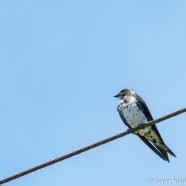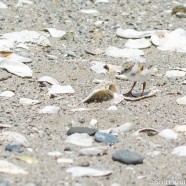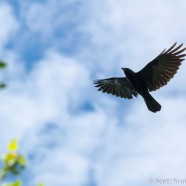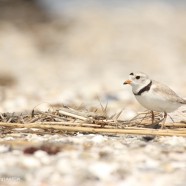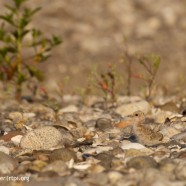Purple Martin Wire
There are precious few moments for Purple Martins (Progne subis) to rest at this time of the year with so many hungry mouths to feed back at their gourd. All of the cool butterflies and dragonflies that we regularly post are prey for these birds, and if you visit an especially populated gourd colony you will end up finding parts of them on the ground underneath. They used to be billed as mosquito eaters to help sell those apartments (ain’t marketing grand?) but the Purple Martin relies on much larger prey. If you ever have the chance to watch them feeding their young be prepared for...
Read MorePiping Plover Hatchlings & WildLife Guards
A Piping Plover pair at Bridgeport, Connecticut’s Pleasure Beach became new parents to four tiny hatchlings either very late on the night of Thursday, June 18 or early in the morning of Friday, June 19. Our work in the Audubon Alliance for Coastal Waterbirds makes them our responsibility. These birds are the City’s one pair for the 2015 season, and with Pleasure Beach being open to the public for a second year after being off limits for nearly 20 years and overrun with predators. I visited them with Audubon Connecticut’s Important Bird Area Program Coordinator Corrie...
Read MoreFish Crow Marauders
This is a marauding Fish Crow (Corvus ossifragus), as identified by voice, flying through a neighborhood and searching for nests to raid. If you have a lot of experience with them you can get used to picking out the slightly smaller Fish vs. American Crow as well. Whether it is tiny hatchlings or developing eggs the many nests that fill our lands, from forest to shore, are often extremely tempting targets for corvids at this point in the season. Both a male and female Baltimore Oriole were aggressively attacking this bird until it vacated the area. Groups of Fish Crow are an enormous threat...
Read MorePiping Plovers Increasing
We have a lot of tiny Piping Plover hatchlings popping out on beaches across Connecticut right now, but we even have additional pairs and adult birds showing up on territories. These birds may have lost their nest somewhere else, or even a mate, and are searching for new prime real estate and other individuals who have not paired off. Sean took this photo of Milford Point’s eighth (!) pair of Piping Plovers! The entire coast of the town of Milford is one of the best Piping Plover areas in the state, and the birds certainly want to nest there, though there are only so many...
Read MoreLeast Tern hatchling (Sternula antillarum)
We have a bunch of our Connecticut locations with hatchling Least Terns right now though they are not anywhere in the state in high numbers this year. They can be a difficult species to predict and protect, sensitive to a multitude of disturbances both natural and introduced by humans and vulnerable to changes in prey levels.
Read More



